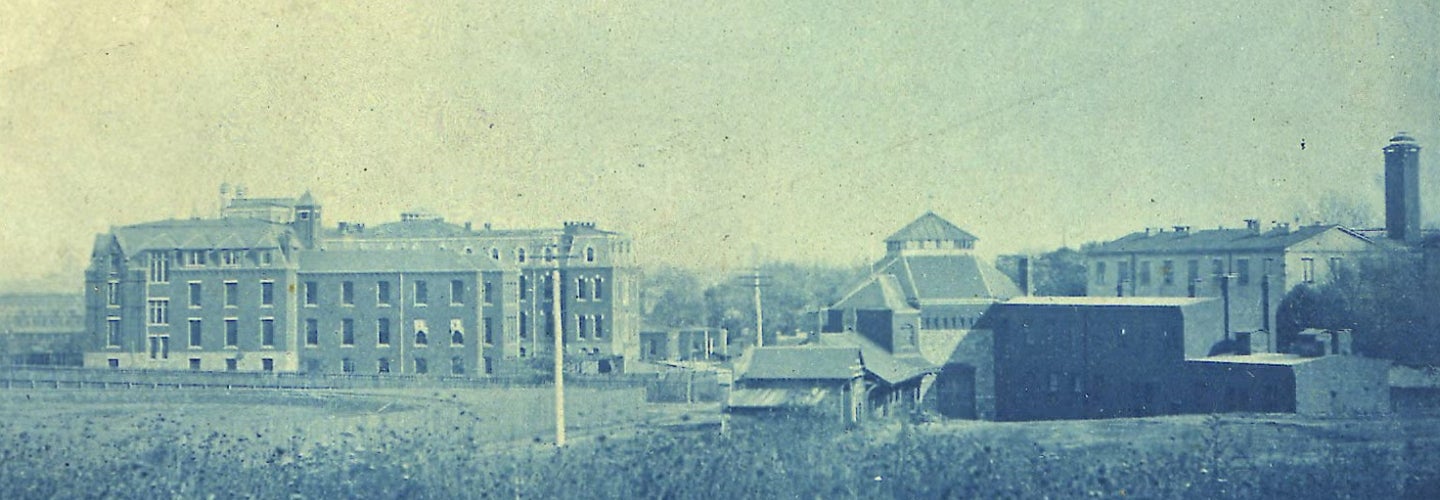
History
Shaping Veterinary Medicine
Penn Vet’s Beginnings
Throughout its history, Penn Vet has been profoundly influenced by an array of remarkable individuals, each of whom has accomplished milestones in veterinary medicine and education. Their contributions and unwavering dedication have played a crucial role in forever shaping the School.
For more on the history of Penn Vet, visit the Guide from the Penn Libraries. You can also peruse past issues of the School magazine, Bellwether.
In 1807, Benjamin Rush, one of the University of Pennsylvania medical school’s original professors, proposed that Penn also offer instruction in veterinary medicine. However, it was not until 1882 that University Trustee Joshua Ballinger Lippincott donated $10,000 to establish a veterinary school within the University. The Veterinary Department was formally opened on October 2, 1884. Beginning a century-long tradition of support, the state of Pennsylvania appropriated $25,000 for the School in 1889.
The School moved to a new location in 1901, and a new building was completed by 1913, with the help of generous individual contributions as well as state appropriations. The school has since resided in this building. By the mid-1930s, the School was offering courses for advanced work in veterinary pathology leading to master and doctoral degrees. The School has been offering graduate courses in cooperation with the Graduate School of Medicine ever since.
Origins of New Bolton Center
The School established an ambulatory clinic in 1937, to aid the clinical instruction in veterinary medicine. Reorganized in 1945, it became the Media Field Station, which served as the School’s clinical center until 1952, when the University acquired a tract of land 32 miles southwest of the University campus. Named New Bolton Center, it has been a major base for teaching, research, and clinical services in veterinary medicine.
Innovating
Research
For 140 years, Penn Vet researchers have transformed veterinary medicine, improved animal health and welfare, and also contributed to significant advances in human medicine. Through the decades the School has been a leader in the use of innovative technology, as well as convening international collaboration on veterinary issues of global significance. Among our many signature achievements are:
- 1900: Penn held the first veterinary continuing education conference for practitioners.
- 1930s: Otto Stader invented the “Stader Splint,” which is eventually is adopted for treating fractures in human patients, including soldiers during World War II.
- 1960s: Hilary Koprowski, director of the Wistar Institute, developed a new tissue culture-based rabies vaccine that was more effective and less painful than the traditional Pasteur technique.
- 1970s: Jacques Jenny established specialty of equine orthopaedic surgery, and Penn Vet developed the world’s first recovery pool for horses after orthopaedic surgery.
- 1990s: A team at New Bolton Center, under the guidance of Jim Ferguson, developed an integrated program of systematic breeding of dairy cows, a strategy still in use by the global dairy industry. The world’s first animal bloodmobile entered service at Ryan Veterinary Hospital in 1991. In 1996, Gail Smith received a patent for the PennHIP method of assessing canine hip dysplasia.
- 2000s: Gustavo Aguirre’s team, in collaboration with Cornell University researchers, was the first to restore vision in a blind dog (named Lancelot) using gene therapy. In 2005, Charles Vite performed the first successful gene therapy treatment of a central nervous system disease (α-mannosidosis) in a large animal model (cats).
- 2010s: Ralph Brinster was awarded the National Medal of Science, the U.S. government’s highest honor for scientists, for his research on reproductive biology and genetics. He was the first veterinarian (and one of the few scientists from an agricultural background) to receive this award. Also during this decade, Penn Vet became the first veterinary teaching hospital in the world to use the EQUIMAGINE™ robotics-controlled imaging system, which had clinical and research applications for human as well as animal medicine.
- 2018: Susan Volk received a patent for her approach to reengineering the tumor microenvironment, using collagen type III, to prevent metastatic spread following surgical removal of tumors.
- 2022: Katrin Hinrichs and collaborators published the first successful method for equine standard in vitro fertilization (IVF), culminating in the production of viable blastocysts and the birth of healthy foals.
- 2024: Mary Beth Callan and collaborators successfully performed AAV gene therapy in dogs with hemophilia, demonstrating lasting efficacy and improved quality of life.
Evolving
Veterinary Medicine
Women at Penn Vet
The faculty voted to admit women to the course in veterinary medicine in 1933, and the first woman to earn a VMD at Penn was Josephine Deubler, who graduated from the School in 1938. Penn subsequently graduated two women from its veterinary school in 1939, one in 1940, and more than 100 over the next three decades. Today women scientists lead three of the School’s most prestigious centers and programs:
- Working Dog Center (Cynthia Otto, DVM, PhD, director)
- Wildlife Futures (Julie Ellis, MS, PhD, and Lisa Murphy, VMD, co-directors)
- Shelter Medicine and Community Engagement (Brittany Watson, VMD, PhD, director)
Notable Early Black Graduates from Penn Vet
August Nathaniel Lushington, V’1897, was the first African American to earn a Doctor of Veterinary Medicine (VMD) at the University of Pennsylvania. After about two years in Philadelphia, he practiced for much of his career life in highly segregated Lynchburg, Virginia, earning a reputation as a superior practitioner in the community.
Graduating a Pioneering Olympic Champion: Penn Vet alumnus John Baxter Taylor, Jr. V’1908 (1882–1908), a track and field athlete, was the first Black Olympic gold medalist. He won the medal in London in 1908, shortly after graduating from Penn. Tragically, he died later that same year of typhoid at age 26.
